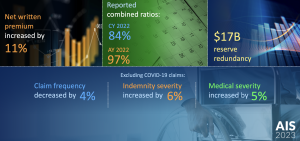That’s the only conclusion one could draw from this year’s NCCI State of the Line report.
Very profitable despite declining premium rates, eye-watering pre-tax operating gains, and eight straight years of very solid profits…the corks must have been popping down in Orlando.
(wasn’t able to make the event this year…boys’ annual mountain biking trip kinda took precedence…thanks to NCCI’s Cristine Pike for keeping me in the loop!)
Details..
- private carriers’ pretax operating gain of 25% – within an eyelash of the record year of 2018
- loss ratio of 43%…43%!!! – the lowest in two decades.
- combined ratio was 84%
- lost time claim frequency dropped 4 points
- $17 billion in excess reserves
This last is most striking as it is incontrovertible proof that premium rates are still far too high.

There are a bunch of implications that we’ll dive into in the next few days, but let’s start with the biggest one:
Why are employers and taxpayers still paying way too much for worker’s comp?
I predicted this back in 2019 – in a word, opioids.



to better understand the high rates for WC insurance., I would first look at the combined ratios of leading state funds which should by driving the markets in their respective states… starting with MEMIC in Maine and Pinnacol in Colorado. I would also look at barriers to entry of new workers comp insurers. then I would look at the self insurance market. Then I would look at high deductibles, whether they are in effect shieldng employers from high costs
Thanks Peter – not sure I follow you re state funds and how that affects premium rates set by regulators in many states. Also not sure what examining those other entities/factors might inform the discussion.
apologies for my obtuseness.
be well Joe